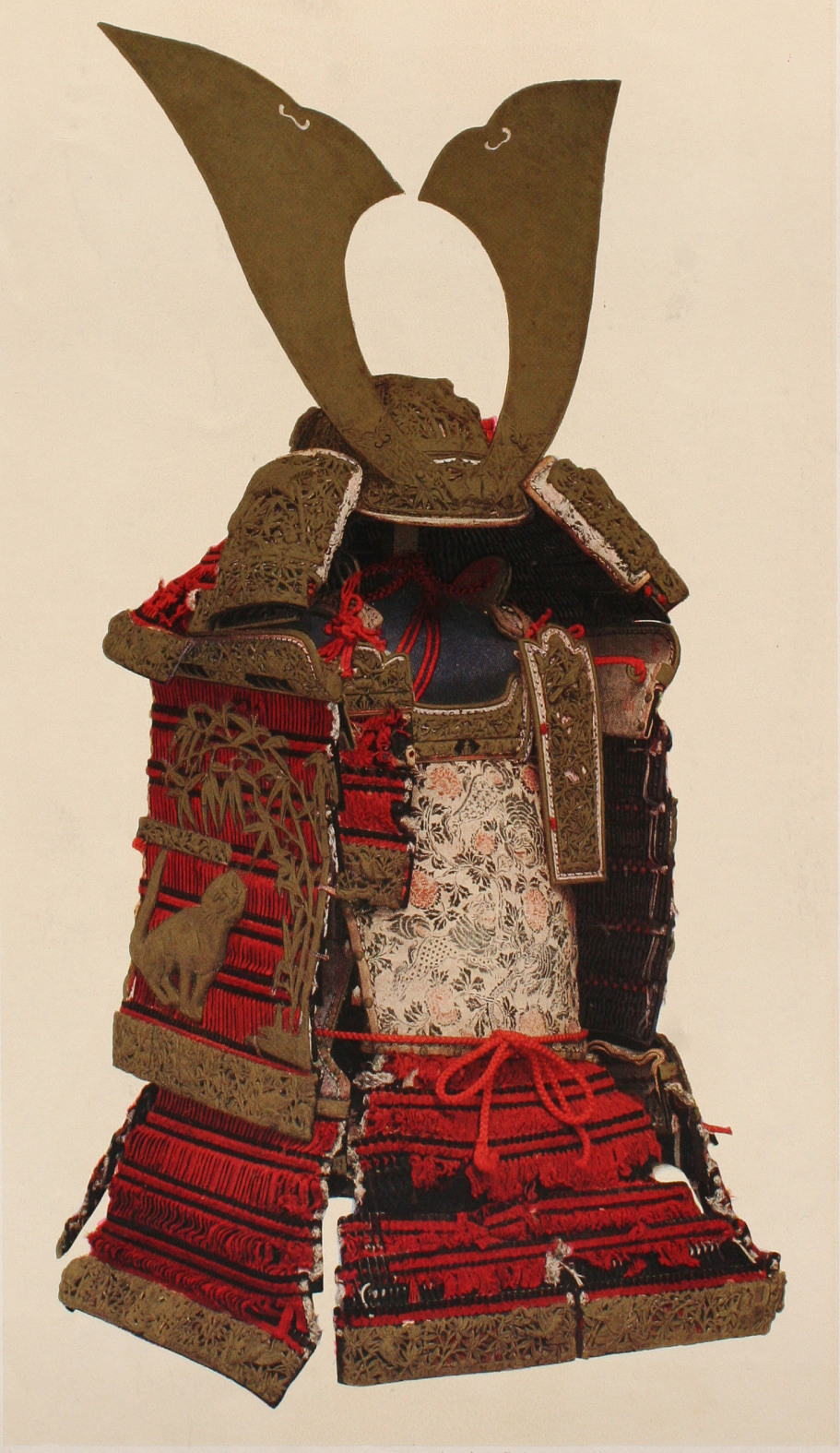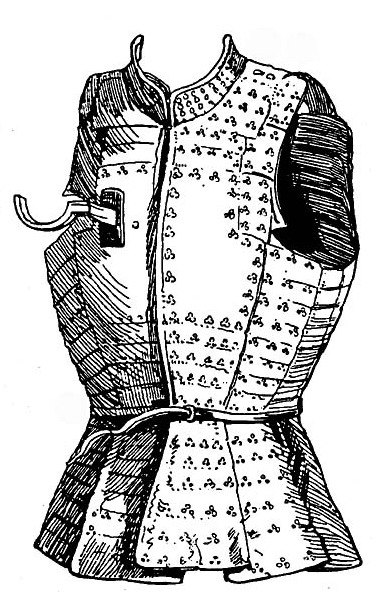|
Tatami-do
''Tatami'' (畳具足), or ''tatami gusoku'' (from ''tatamu'' 畳む, "to fold") and ''gusoku'' (meaning full suit of armour), was a type of lightweight portable folding Japanese armour worn during the feudal era of Japan by the samurai class and their foot soldiers (ashigaru). The ''Tatami dō'' (a foldable cuirass) or the ''tatami katabira'' (an armoured jacket) were the main components of a full suit of tatami armour. Structure A '' tatami gusoku'' (complete suit of folding armor) includes a ''tatami dō'' or '' tatami katabira'' (jacket) and a ''tatami kabuto'' (helmet) '' chochin kabuto'', or '' tatami zukin'' (hood) or similar type of head protection along with the other related parts of a full suit of Japanese armour. Collapsible head protection such as '' hachi gane'' and other collapsible armor are also ''tatami'' armor; a traditional kabuto could also be part of a tatami gusoku. Tatami armour was lightweight, portable, convenient for transportation, and they were ma ... [...More Info...] [...Related Items...] OR: [Wikipedia] [Google] [Baidu] |
Plated Mail
Mail and plate armour (plated mail, plated chainmail, splinted mail/chainmail) is a type of mail with embedded plates. Armour of this type has been used in the Middle East, North Africa, Ottoman Empire, Japan, China, Korea, Vietnam, Central Asia, Greater Iran, India, Eastern Europe, and Nusantara. Types In Russia there are three known varieties of mail and plate armour. These were adopted from Persian, initially as Persian exports, and have Persian names. * Behterets (russian: Бехтерец), from Persian ''behter'':Leonid A. Bobrov "Iron hawks from the territory of Maveranahr" (sets of the defensive equipment of the warriors of the Middle Asia and the neighbouring territories in 16th–17th centuries) small horizontal plates arranged in vertical rows without gaps, joined by rings, and embedded in mail. * Yushman (russian: Юшман), from Persian ''jawshan'': long horizontal plates embedded in mail and resembling laminar armour (e.g. Roman lorica segmentata) * Kalant ... [...More Info...] [...Related Items...] OR: [Wikipedia] [Google] [Baidu] |
Japanese Armour
Scholars agree that Japanese armour first appeared in the 4th century, with the discovery of the cuirass and basic helmets in graves. During the ''Heian period'' (794-1185), the unique Japanese samurai armour ''ō-yoroi'' and ''dō-maru'' appeared.式正の鎧・大鎧 Costume Museum The Japanese cuirass evolved into the more familiar style of worn by the samurai known as the dou or dō, with the use of leather straps (nerigawa), and lacquer for weatherproofing. Leather and/or iron scales were also used to construct samurai armours, with leather and eventually silk lace used t ... [...More Info...] [...Related Items...] OR: [Wikipedia] [Google] [Baidu] |
:Category:Japanese Words And Phrases ...
{{Commons Words and phrases by language Words Words Words A word is a basic element of language that carries an objective or practical meaning, can be used on its own, and is uninterruptible. Despite the fact that language speakers often have an intuitive grasp of what a word is, there is no consen ... [...More Info...] [...Related Items...] OR: [Wikipedia] [Google] [Baidu] |
Bloomsbury Publishing
Bloomsbury Publishing plc is a British worldwide publishing house of fiction and non-fiction. It is a constituent of the FTSE SmallCap Index. Bloomsbury's head office is located in Bloomsbury, an area of the London Borough of Camden. It has a US publishing office located in New York City, an India publishing office in New Delhi, an Australia sales office in Sydney CBD and other publishing offices in the UK including in Oxford. The company's growth over the past two decades is primarily attributable to the ''Harry Potter'' series by J. K. Rowling and, from 2008, to the development of its academic and professional publishing division. The Bloomsbury Academic & Professional division won the Bookseller Industry Award for Academic, Educational & Professional Publisher of the Year in both 2013 and 2014. Divisions Bloomsbury Publishing group has two separate publishing divisions—the Consumer division and the Non-Consumer division—supported by group functions, namely Sales and Mar ... [...More Info...] [...Related Items...] OR: [Wikipedia] [Google] [Baidu] |
Brigandine
A brigandine is a form of body armour from the Middle Ages. It is a garment typically made of heavy cloth, canvas, or leather, lined internally with small oblong steel plates riveted to the fabric, sometimes with a second layer of fabric on the inside. Origins Protective clothing and armour have been used by armies from earliest recorded history; the King James Version of the Bible (Jeremiah 46:4) translates the Hebrew סריון ''ÇiRYON'' or שריון ''SiRYoN'' "coat of mail" as "brigandine". Medieval brigandines were essentially a refinement of the earlier coat of plates, which developed in the late 12th century, typically of simpler construction with larger metal plates. This armour of Asian origin reached Europe after the Mongol invasion in 1240 that destroyed the Kievan Rus' and severely damaged the Kingdom of Hungary in 1241. The new armour became very popular first in Eastern Europe, especially in Hungary, towards the end of the 13th century and was adopted in west ... [...More Info...] [...Related Items...] OR: [Wikipedia] [Google] [Baidu] |
Dou (dō)
DOU or Dou may refer to: * Dou (surname) (窦/竇), a Chinese surname ** Empress Dou (other), Chinese empresses surnamed Dou * Degree of unsaturation, in chemistry * Dhammakaya Open University, near Bangkok, Thailand * Gerrit Dou (1613–1675), Dutch Golden Age painter * A traditional Chinese unit of measurement, equivalent to a decaliter See also * Dou dizhu ''Dou dizhu'' () is a card game in the genre of shedding and gambling. It is one of the most popular card games played in China. ''Dou dizhu'' is described as easy to learn but hard to master, requiring mathematical and strategic thinking as we ..., a Chinese card game {{disambiguation, surname Surnames of Dutch origin ... [...More Info...] [...Related Items...] OR: [Wikipedia] [Google] [Baidu] |
Metropolitan Museum Of Art
The Metropolitan Museum of Art of New York City, colloquially "the Met", is the largest art museum in the Americas. Its permanent collection contains over two million works, divided among 17 curatorial departments. The main building at 1000 Fifth Avenue, along the Museum Mile on the eastern edge of Central Park on Manhattan's Upper East Side, is by area one of the world's largest art museums. The first portion of the approximately building was built in 1880. A much smaller second location, The Cloisters at Fort Tryon Park in Upper Manhattan, contains an extensive collection of art, architecture, and artifacts from medieval Europe. The Metropolitan Museum of Art was founded in 1870 with its mission to bring art and art education to the American people. The museum's permanent collection consists of works of art from classical antiquity and ancient Egypt, paintings, and sculptures from nearly all the European masters, and an extensive collection of American and modern ... [...More Info...] [...Related Items...] OR: [Wikipedia] [Google] [Baidu] |
Yale University Press
Yale University Press is the university press of Yale University. It was founded in 1908 by George Parmly Day, and became an official department of Yale University in 1961, but it remains financially and operationally autonomous. , Yale University Press publishes approximately 300 new hardcover and 150 new paperback books annually and has a backlist of about 5,000 books in print. Its books have won five National Book Awards, two National Book Critics Circle Awards and eight Pulitzer Prizes. The press maintains offices in New Haven, Connecticut and London, England. Yale is the only American university press with a full-scale publishing operation in Europe. It was a co-founder of the distributor TriLiteral LLC with MIT Press and Harvard University Press. TriLiteral was sold to LSC Communications in 2018. Series and publishing programs Yale Series of Younger Poets Since its inception in 1919, the Yale Series of Younger Poets Competition has published the first collection of ... [...More Info...] [...Related Items...] OR: [Wikipedia] [Google] [Baidu] |
Mail (armour)
Chain mail (properly called mail or maille but usually called chain mail or chainmail) is a type of armour consisting of small metal rings linked together in a pattern to form a mesh. It was in common military use between the 3rd century BC and the 16th century AD in Europe, and longer in Asia and North Africa. A coat of this armour is often called a hauberk, and sometimes a byrnie. History The earliest examples of surviving mail were found in the Carpathian Basin at a burial in Horný Jatov, Slovakia dated at 3rd century BC, and in a chieftain's burial located in Ciumești, Romania. Its invention is commonly credited to the Celts, [...More Info...] [...Related Items...] OR: [Wikipedia] [Google] [Baidu] |
Kusari (Japanese Mail Armour)
''Kusari gusoku'' (chain armour)(鎖具足) is the Japanese term for mail armour. Kusari is a type of armour used by the samurai class and their retainers in feudal Japan. When the word ''kusari'' is used in conjunction with an armoured item it usually means that the ''kusari'' makes up the majority of the armour defence. History and description The Japanese had more varieties of mail than all the rest of the world put together. ''Kusari'' was used in samurai armour at least from the time of the Mongol invasions (1270s) but particularly from the Nanboku-chō period (1336–1392). Kusari was typically made with rings that were much smaller than their European counterparts, and patches of kusari were used to link together plates and to drape over vulnerable areas such as the underarm. Most common parts of samurai armour could be made with kusari as the main armour defense as well as many types of garments including ''jackets'', '' hoods'', ''gloves'', ''vests'', '' shin'', should ... [...More Info...] [...Related Items...] OR: [Wikipedia] [Google] [Baidu] |
Osprey Publishing
Osprey Publishing is a British, Oxford-based, publishing company specializing in military history. Predominantly an illustrated publisher, many of their books contain full-colour artwork plates, maps and photographs, and the company produces over a dozen ongoing series, each focusing on a specific aspect of the history of warfare. Osprey has published over 2,300 books. They are best known for their ''Men-at-Arms'' series, running to over 500 titles, with each book dedicated to a specific historical army or military unit. Osprey is an imprint of Bloomsbury Publishing. History In the 1960s, the Brooke Bond Tea Company began including a series of military aircraft cards with packages of their tea. The cards proved popular, and the artist Dick Ward proposed the idea of publishing illustrated books about military aircraft. The idea was approved and a small subsidiary company called Osprey was formed in 1968. The company’s first book, ''North American P-51D Mustang in USAAF-USAF Ser ... [...More Info...] [...Related Items...] OR: [Wikipedia] [Google] [Baidu] |






